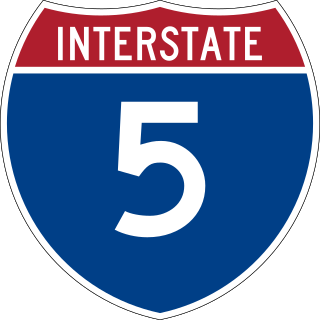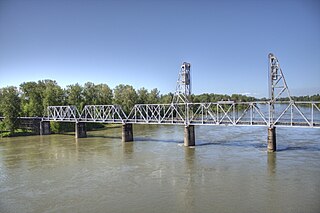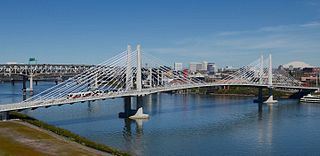
Eugene is a city in and the county seat of Lane County, Oregon, United States. It is located at the southern end of the Willamette Valley, near the confluence of the McKenzie and Willamette rivers, about 50 miles (80 km) east of the Oregon Coast.

The Willamette River is a major tributary of the Columbia River, accounting for 12 to 15 percent of the Columbia's flow. The Willamette's main stem is 187 miles (301 km) long, lying entirely in northwestern Oregon in the United States. Flowing northward between the Oregon Coast Range and the Cascade Range, the river and its tributaries form the Willamette Valley, a basin that contains two-thirds of Oregon's population, including the state capital, Salem, and the state's largest city, Portland, which surrounds the Willamette's mouth at the Columbia.

Autzen Stadium is an outdoor football stadium in Eugene, Oregon, United States. Located north of the University of Oregon campus, it is the home field of the Oregon Ducks of the Big Ten Conference. Opened in 1967, the stadium has undergone several expansions. The official seating capacity is presently 54,000 to 60,000 ; however, the actual attendance regularly exceeds that figure.

David B. "Dave" Frohnmayer was an American attorney, politician, and academic administrator from Oregon. He was the 15th president of the University of Oregon, serving from 1994 to 2009. His tenure as president was the second-longest after John Wesley Johnson. He was the first native Oregonian to run the University of Oregon. Frohnmayer previously served as Oregon Attorney General from 1981 to 1991, and subsequently served as dean at the University of Oregon School of Law before serving as president of the university. He served in an "of counsel" attorney role with the Oregon law firm, Harrang Long Gary Rudnick P.C.

The McKenzie River is a 90-mile (145 km) tributary of the Willamette River in western Oregon in the United States. It drains part of the Cascade Range east of Eugene and flows westward into the southernmost end of the Willamette Valley. It is named for Donald McKenzie, a Scottish Canadian fur trader who explored parts of the Pacific Northwest for the Pacific Fur Company in the early 19th century. As of the 21st century, six large dams have been built on the McKenzie and its tributaries.

Alton Baker Park is located in Eugene, Oregon, United States, near Autzen Stadium. In June 1967, it was dedicated to Alton F. Baker Sr., the eleventh owner of Eugene's The Guard newspaper. It features duck ponds, bicycle trails, a dog park and a disc golf course, and directly touches the Ferry Street Bridge across the Willamette River.

The Oregon Ducks are the intercollegiate athletic teams that represent the University of Oregon, located in Eugene. The Ducks compete at the National Collegiate Athletic Association (NCAA) Division I level as a member of the Big Ten Conference. With eighteen varsity teams, Oregon is best known for its American football team and track and field program, which has helped Eugene gain a reputation as "Track Town, USA". Oregon's main rivalries are with the Oregon State Beavers and the Washington Huskies.

Pre's Trail, located on the north side of the Willamette River in Eugene, Oregon, United States, popularly referred to as "Track Town USA", is a four-mile-long running and walking trail named after heralded University of Oregon athlete Steve Prefontaine. The woodchip-and-bark trail features riparian scenery, including grasslands, duck ponds, and woods, as well as guide signs with trail maps at each of three primary trailheads. Near downtown Eugene, in Alton Baker Park, Pre's Trail is part of an extensive network of running trails in and around the university town and neighboring Springfield.

The campus of the University of Oregon is located in Eugene, Oregon, and includes some 80 buildings and facilities, including athletics facilities such as Hayward Field, which was the site of the 2008 Olympic Track and Field Trials, and McArthur Court, and off-campus sites such as nearby Autzen Stadium and the Riverfront Research Park. An online guide published by the University of Oregon Libraries, Architecture of the University of Oregon, describes campus buildings and provides timelines of key architectural events linked with campus history.

Interstate 5 (I-5) in the U.S. state of Oregon is a major Interstate Highway that traverses the state from north to south. It travels to the west of the Cascade Mountains, connecting Portland to Salem, Eugene, Medford, and other major cities in the Willamette Valley and across the northern Siskiyou Mountains. The highway runs 308 miles (496 km) from the California state line near Ashland to the Washington state line in northern Portland, forming the central part of Interstate 5's route between Mexico and Canada.

The Union Street Railroad Bridge is a vertical lift, Pratt through truss bridge that spans the Willamette River in Salem, Oregon, United States, built in 1912–13. It was last used by trains in the early 1990s and was sold for one dollar in 2003 to the City of Salem, which converted it to bicycle and pedestrian use in 2008–2009. It was added to the National Register of Historic Places in 2006.

Tilikum Crossing, Bridge of the People is a cable-stayed bridge across the Willamette River in Portland, Oregon, United States. It was designed by TriMet, the Portland metropolitan area's regional transit authority, for its MAX Orange Line light rail passenger trains. The bridge also serves city buses and the Portland Streetcar, as well as bicycles, pedestrians, and emergency vehicles. Private cars and trucks are not permitted on the bridge. It is the first major bridge in the U.S. that was designed to allow access to transit vehicles, cyclists and pedestrians but not cars.

The Ferry Street Bridge is a bridge that spans the Willamette River in Eugene, Oregon, United States. It is located near downtown Eugene, where the city's founder Eugene Skinner once operated a ferry service. The bridge is at Willamette river mile 182.2, and is a block west of the north terminus of the actual Ferry Street. The neighborhood immediately north of the Willamette River near the bridge is often called the "Ferry Street Bridge area."

The Willamette River is a 187-mile (301 km) tributary of the Columbia River in the U.S. state of Oregon. The upper tributaries of the Willamette originate in mountains south and southeast of the twin cities of Eugene and Springfield. Formed by the confluence of the Middle Fork Willamette River and Coast Fork Willamette River near Springfield, the main stem meanders generally north from source to mouth. The river's two most significant course deviations occur at Newberg, where the stream turns sharply east, and about 18 miles (29 km) downriver from Newberg, where it turns north again. Near its mouth, the river splits into two channels that flow around Sauvie Island. The main channel enters the Columbia about 101 miles (163 km) from the larger stream's mouth on the Pacific Ocean, and the smaller Multnomah Channel enters the Columbia about 14.5 miles (23.3 km) further downstream near St. Helens in Columbia County.

Bicycle use in Portland, Oregon has been growing rapidly, having nearly tripled since 2001; for example, bicycle traffic on four of the Willamette River bridges has increased from 2,855 before 1992 to over 16,000 in 2008, partly due to improved facilities. The Portland Bureau of Transportation says 6% of commuters bike to work in Portland, the highest proportion of any major U.S. city and about 10 times the national average.

The Peter DeFazio Bridge is a bicycle and pedestrian bridge located in Eugene, Oregon, that crosses the Willamette River. The bridge was completed in 2000 and cost $2.8 million.

Knickerbocker Bicycle Bridge is a bridge across the Willamette River in Eugene, Oregon, United States. The bridge was dedicated in 1980.

Mark Frohnmayer is a software and electric vehicle entrepreneur. He was the lead programmer of Starsiege: Tribes and Tribes 2 at Dynamix before leaving to co-found GarageGames, where he helped architect the Torque Game Engine and led the development of Zap! The Game, Marble Blast Gold and Marble Blast Ultra.
Frohnmayer or Frohnmaier is a surname. Notable people with the surname include:


















